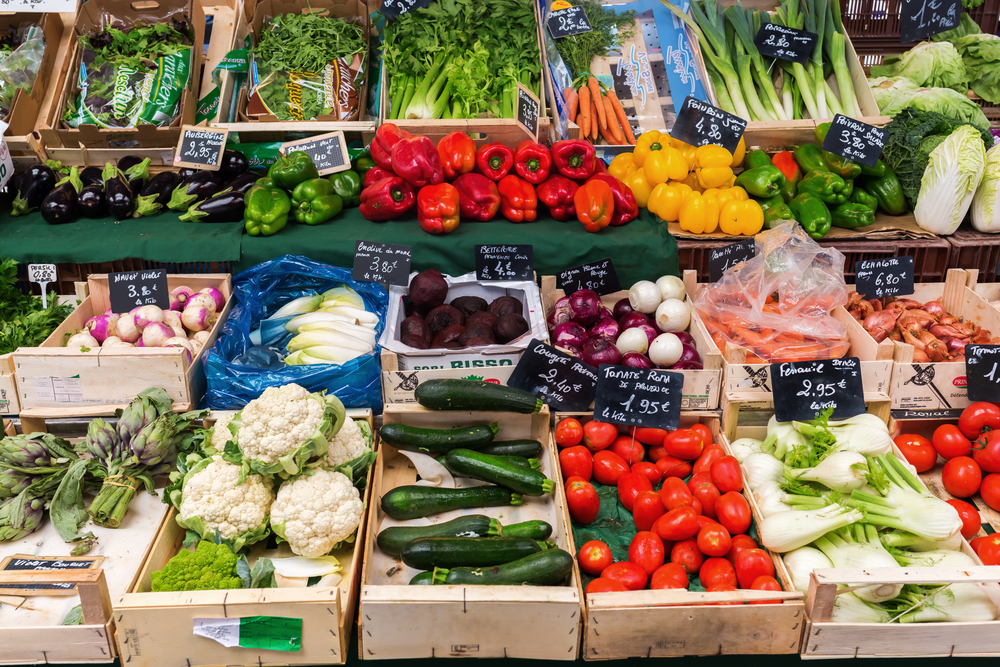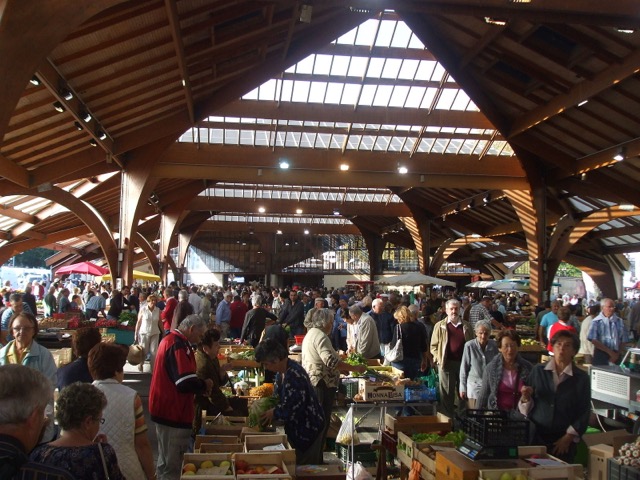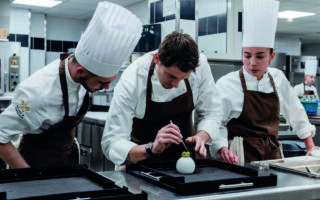
Best market in France 2023: Nominees
Revealed: the markets in the running for France’s Plus Beau Marché 2023
Twenty-four regional markets are competing for the title of Plus Beau Marché 2023 – and viewers of TV channel TF1 have until May 25 to cast their votes. So who will take the crown from last year’s winner, Narbonne? You’ll have to wait and see: the finalists will be whittled down to a shortlist of ten and the overall winner will be revealed at the end of June. In the meantime, here’s a quick look at the 24 hopefuls.
Alsace: Marché couvert de Colmar (Haut-Rhin)
The covered market of Colmar celebrated its 12th birthday last year. Fresh vegetables, spices, fish, dairy, local specialities and restaurants create a real gourmet experience, while the terrace seems to float on the waters of the Lauch which borders the 19th-century building built by architect Louis-Michel Boltz.
Antilles/Guyane: Marché aux épices de Pointe-à-Pitre (Guadeloupe)
The Saint-Antoine market, also called the Spice Market, is a riot of colour and smells: nutmeg, cloves, cinnamon, vanilla, punches made from tropical fruits… The market spreads out under a large canopy which was renovated in 2006.
Aquitaine: Marché de La Réole (Gironde)
Frequented by several thousand people every week on the banks of the Garonne, the market of La Réole offers quality products and the chance to meet friends, have a drink and a chat and taste the produce, of course!
Auvergne: Marché du Puy-en-Velay (Haute-Loire)
Every week, the produce of the Haute-Loire countryside fills the Place du Plot, attracting crowds of locals as well as tourists. Be sure to check out the excellent local cheese.
Basse-Normandie: Marché de Saint-Pierre-en-Auge (Calvados)
In the exceptional setting of les halles, small local producers offer products such as cream, eggs, cheeses, honey, pastries, jam… all guaranteed to tickle the taste buds.
Bourgogne: Marché de Chablis (Yonne)
In the Yonne, the Chablis market is a popular event for locals and visitors alike. Created in 1966, the Sunday event calls itself ‘The Burgundian Market’, a nod to the presence of many regional artisans crowding the alleys.
Bretagne: Marché de Vannes (Morbihan)
The half-timbered houses add to the charm of this popular market, known especially for seafood from the Gulf of Morbihan oysters from Arradon, vegetables from its market gardeners and cheeses such as Tomme de Rhuys.
Centre: Marché d’Argenton (Indre)
The Argenton market was originally set up on Place Carnot, near the Saint-Sauveur church and joined the nearby covered hall in 1965. Expect quality organic produce.
Champagne-Ardenne: Marché des Halles du Boulingrin de Reims (Marne)
Since 1929, the Halles du Boulingrin have been an integral part of Reims’ identity, symbolising the reconstruction after the First World War. It’s is an ideal place to experience the terroir and chat to the passionate local producers.
Corse: Marché de l’Île-Rousse (Haute-Corse)
Built in 1884 in the heart of the city, near Place Paoli, the Île-Rousse market consists of a slate esplanade covered with a massive roof and a wooden frame held by 21 columns. It has been classified as a historical monument since 1998. Look out for fruits and vegetables as well as fish caught the same morning or cold cuts, in the cold season. Farmer cheese, AOC honey or the famous canistrelli are available all year round.
Franche-Comté: Marché Fréry de Belfort (Territoire de Belfort)
Here, regional products are in the spotlight, whether they are Franche-Comtois or Alsatian. Located in the city centre of Belfort, this covered market was built in the early 20th century. It’s the ideal spot to taste local wines (mainly from Alsace), or enjoy breakfast.
Haute-Normandie: Marché d’Yvetot (Seine Maritime)
Yvetot is the most beautiful market in the Pays de Caux. The Wednesday market offers food, clothing and accessories. The Saturday market, with about 40 stall-holders, is devoted almost entirely to food, with a large selection of fresh and local products.
Île-de-France: Marché du centre-ville de Rueil-Malmaison (Hauts-de-Seine)
A century-old institution, the Jean Jaurès market in Rueil-Malmaison is held every Tuesday and Saturday morning in the heart of the city. A friendly place, it offers a wide variety of fresh, local and quality products to nearly 8,000 customers who turn up each week to soak up atmosphere and gourmet offerings.
Languedoc-Roussillon: Marché des Halles de Sète (Hérault)
Built in the Baltard style in 1890 and completely renovated in 2011, the Halles de Sète are home to more than 50 traders. Look out for treats such as octopus and tomato sauce or oysters from the Étang de Thau.
Limousin: Marché de Brive-la-Gaillarde (Corrèze)
The market of Brive-la-Gaillarde, made famous by the song Hécatombe by Georges Brassens, is held on Saturday mornings on the Place de la Guierle. The cuisine of the southwest is evident in its offering of foie gras, truffles and duck.

Lorraine: Marché couvert de Metz (Moselle)
Near the cathedral, there is both drinking and eating, as well as shopping at his much-loved market, which sells fresh regional products sold at a fair price.
Midi-Pyrénées: Marché de Grenade (Haute-Garonne)
Every Saturday, the regulars of the market of Granada, north-west of Toulouse, head to this medieval hall, the largest in Europe with hexagonal pillars. Some 5,000 customers crowd around 150 stands, almost doubling the population of 9,500 inhabitants.
Nord-Pas-de-Calais: Marché d’Arras (Pas-de-Calais)
In Arras, for ten centuries, the grain market has punctuated the life of the Grand’Place. Located in the heart of the Place des Héros, at the foot of the famous belfry, the market hosts more than 200 colourful and gourmet stalls offering local products, food and handicrafts.
Provence-Alpes-Côte d’Azur: Marché de Garéoult (Var)
A must in Provence, the Garéoult Market offers clothing, arts and crafts, local products, seasonal fruits and vegetables, and is a delight to browse.
Pays-de-la-Loire: Marché des Sables d’Olonne (Vendée)
Built 15 years after the end of the Second Empire, under the Third Republic, the building was inaugurated in 1890. The central halls are spread over two levels, as they are built on the site of an old dune. The elegant building brings together about 50 traders, under this structure that combines glass and cast iron.
Picardie: Marché Etréaupont (Aisne)
Taking place every third Saturday of the month, the market of the Fanes de Carottes in Étréaupont is unmissable. As well as local produce, there are artistic and decoration workshops and concerts, in addition to spaces reserved for the discovery of the local gastronomy.
Poitou-Charentes: Marché de Thouars (Deux-Sèvres)
According to historians, it has been at least 700 years since the fair and then the market has been central to life in Thouars. At the height of the summer season, more than 200 pitches can be found in les halles and on the huge Place Lavault.
La Réunion: Marché de Saint-Pierre
Famous for its colours, perfumes, smells and spices that characterise Reunion, this market is a dynamic and bustling place to visit at the heart of local life.
Rhône-Alpes: Marché d’Aubenas (Ardèche)
In the heart of downtown, an authentic market with southern flavours brings together local gastronomy, clothing, tools, wellness productsand fashion. With nearly 150 colourful stalls, the market square comes alive every weekend.
Latest posts:
- Canard au sang
- Oeufs en meurette
- Le Goûter: The Sweetest Part of the Day
- Fabien Ferré: Jumping from 0 to 3 Michelin Stars
- Sardines and onions summer tart
Lead photo credit : (c) Shutterstock
Share to: Facebook Twitter LinkedIn Email
More in Food Market, France’s best markets 2023, French market, Markets in France



